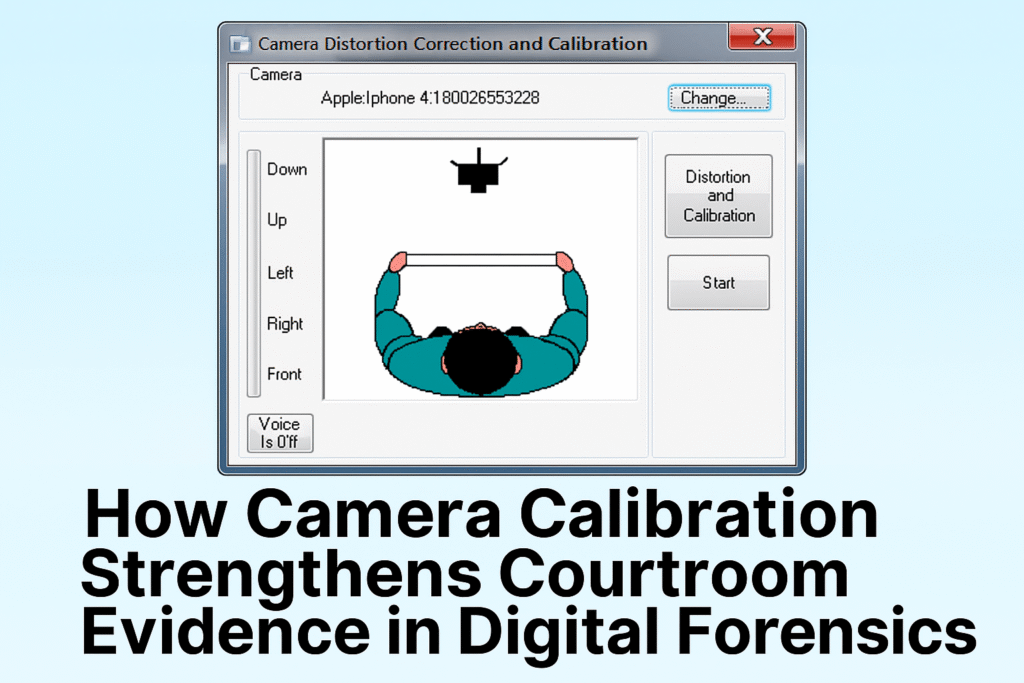How Camera Calibration Strengthens Courtroom Evidence in Digital Forensics
In today’s world, video is often the most powerful type of evidence used in court. From security footage to mobile phone recordings, videos can show events in ways that words cannot. But for video to hold up in a courtroom, it must be accurate and free of errors. This is where camera calibration and lens correction play a vital role.
What Is Camera Calibration?
Cameras do not always record the world as it truly is. A lens may bend straight lines, change angles, or distort shapes. This can lead to mistakes when investigators try to measure objects or track movements in video.
Camera calibration is the process of correcting these distortions. It adjusts the way a camera sees the world, making sure the video output matches real-world dimensions. For forensic experts, this step is critical. Without calibration, even the smallest error could create doubt in a courtroom.
Cognitech’s AutoMeasure software includes an advanced camera calibration module. It guides users step by step, with constant feedback, to ensure the calibration process is accurate and reliable.
Why Lens Correction Matters
Another challenge with video is lens distortion. Wide-angle and low-quality lenses often curve or stretch parts of the image. In a forensic case, this can make people, objects, or distances appear different than they actually are.
Real-time lens correction solves this problem. By removing geometric distortion as the video is captured, it creates a true-to-life image that can be trusted. Cognitech’s TriSuite64 offers real-time lens correction to ensure that investigators work with undistorted video from the start.
For courts, this is critical. A corrected video can be used to verify claims, reconstruct crime scenes, and support expert testimony with confidence.
The Role of Forensic Video Software
Modern cases often rely on forensic video software to manage the complex process of analyzing digital footage. Cognitech has developed a full suite of tools designed for investigators and law enforcement agencies.
- AutoMeasure uses calibrated cameras to perform precise measurements.
- VideoActive ® allows investigators to control supported VCRs for playback.
- Video Conversion ensures even hard-to-read files are transformed without data loss.
- Video Playback provides frame-by-frame or real-time analysis for deeper insights.
These tools together help create a clear and accurate chain of video evidence. Every step, from calibration to playback, supports the legal process by ensuring no detail is lost or distorted.

Impact in the Courtroom
When a video is presented as evidence in a trial, the defense may question its accuracy. If the video has visible distortions, or if its measurements cannot be trusted, it could weaken the case.
But when camera calibration and lens correction are applied, the video becomes much stronger evidence. Investigators can point to the technical steps taken to ensure accuracy. This level of reliability helps judges and juries trust the evidence before them.
In cases involving vehicle accidents, crime scenes, or disputed events, precise calibration allows experts to measure distances, object sizes, and movements with confidence. That precision often makes the difference between doubt and conviction.
Building Trust Through Technology
Digital forensics is more than just collecting video. It is about making sure the video can withstand legal scrutiny. Tools like Cognitech TriSuite64 and AutoMeasure are designed with this goal in mind. By focusing on camera calibration and real-time lens correction, investigators can deliver video evidence that is accurate, reliable, and trusted in court.
See It in Action
Words can only explain so much. To really understand how 3D RAMA® Panorama Measure works, check out this video:
Final Thoughts
In digital forensics, every detail matters. A small lens distortion or calibration error can create big questions in a legal case. That is why advanced forensic video software is so important. By using camera calibration and lens correction, investigators ensure that video evidence is not only clear but also legally defensible.
As technology advances, the standard for courtroom evidence grows higher. With the right forensic tools, experts can meet that standard and strengthen the role of video in the pursuit of justice.
Talk with experts for Forensic video Processing Software and Forensic Image Processing Software solutions. Contact Cognitech! We hope you enjoyed this Blog! Stay tuned, and don’t miss the coming blogs. You can follow us on Twitter, Facebook, Instagram, Linkedln, or Youtube: we post Community Blogs regularly so you won’t miss any!
FAQs
- What is camera calibration in forensic video software?
Camera calibration corrects distortions in video footage, ensuring accurate measurements and true-to-life images that can be trusted in forensic investigations. - Why is lens correction important for courtroom evidence?
Lens correction removes distortion caused by camera lenses. This ensures that video evidence accurately represents real-world scenes and holds up in court. - How does forensic video software help investigators?
Forensic video software like Cognitech TriSuite64 provides tools for calibration, lens correction, video conversion, and playback, making evidence precise and reliable.
4. Can calibrated video be used for 3D crime scene analysis?
Yes. With proper camera calibration, forensic experts can create accurate 3D reconstructions of crime scenes, helping courts visualize events with precision.
